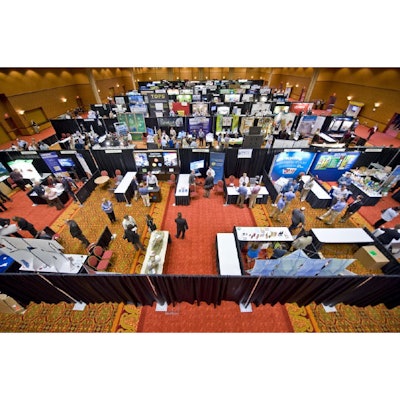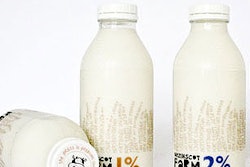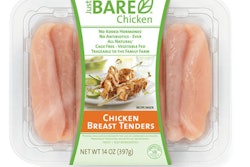
Walmart will be hosting its fifth annual Sustainable Packaging Exposition April 6-7 at the John Q. Hammons Convention Center, just miles from Walmart’s Bentonville, AR, headquarters. As the show has grown over the years, Walmart and Sam’s Club have increasingly raised their expectations for exhibitor claims in an attempt to stamp out greenwashing, including audits of exhibitor materials. The show has also evolved to include educational conference sessions, in addition to the tradeshow floor, to increase the knowledge of sustainable packaging by both packagers and Walmart buyers.
In this exclusive interview, Ron Sasine, senior director of packaging – Private Brands for Walmart Stores, and Robert Parvis, Sam’s Club manager of House Brands Packaging, spoke with GreenerPackage.com managing editor Anne Marie Mohan about the upcoming event.
GreenerPackage.com: How many exhibitors do you expect will attend this year’s event?
Sasine: We tend to have represented somewhere between 150 to 175 exhibitor companies that come to Arkansas for the opportunity to meet both with our own Walmart associates and with representatives of the supplier companies that provide product to Walmart. So in an ideal situation, an exhibitor would come to Arkansas and spend two or three days with us here and have the opportunity to see their immediate customer, who is here as a supplier to Walmart, as well as the Walmart people who are involved in that same product category.
Our goal at the expo is to expose our own Walmart people to the packaging world and sustainability as it impacts packaging. It’s also to provide a good deal of educational information, where packaging supplier organizations will come and present detailed—yet not excruciatingly detailed—information about what’s going on with their specific products and in their specific industry classification. So we will have a presentation on paperboard or corrugated packaging, for example.
In the past, we have had very good information around toxics as they impact packaging, and on green labeling and environmental labeling regulations. We try to provide a balance of the commercial with the educational, so that our Walmart associates really come out of this meeting these two days with a really a good sense of what the state-of-the-art in packaging and packaging sustainability is.
GP: Do you know around how many educational sessions might be offered at the event?
Sasine: Each year, we develop a curriculum for those presentations based on what we think were the most useful and most successful topics in the prior years. We intend to have anywhere between nine and 15 presentations. We are still developing the sessions for 2010, but that is a good estimate of where we think we will land.
GP: Besides packaging suppliers, what other types of exhibitors should attendees expect to see at the show?
Parvis: In the past, we have had academic representation. We have had some representation from trade associations and NGOs. We have also had some booth exhibitors from internal organizations, like our Walmart Transportation or our Walmart - Sam’s Club Logistics.
GP: Can you compare last year’s attendance with that of previous years? Is the show growing? If so, to what do you attribute that growth?
Parvis: Last year, we had slightly fewer booths but keep the same number of attendees. We are really happy that even in the down economy, we are keeping the number of attendees the same. We expect this year we will be able to do the same thing—keep the attendance the same or even hopefully grow it. But the event has definitely grown from the first expo we did. The first expo, which we had five years ago, was actually in the Sam’s Club auditorium, which was basically a large meeting room at our home office here (in Bentonville, AR).
Sasine: I was at the first expo, and I can tell you there was not a lot of elbow room. In many ways, it almost felt like a science fair where everybody had their stuff and lots of people came through and wanted to see it. As the meeting grew and the opportunity for suppliers grew, it took on a much more substantive and developed feel. So it’s been good growth, and I think we are all pleased with it.
GP: Do you think there is a change at all in the type of exhibitors that you are getting or in the products they are offering?
Parvis: My perspective is that their message is becoming more and more focused. One of the things we are really pushing is clear communication, especially around anything related to our sustainability clients. We talked about this last year, the process we implemented for a third-party review of the client. [In 2009, potential exhibitors were required to submit their exhibit materials for audit by a third party to review sustainable packaging claims.]
Sasine: Packaging suppliers are learning the language of Walmart, and they are learning to engage and discuss packaging with Walmart buyers and merchants in a way that in those early years was much more difficult for them.
GP: I am guessing a lot of this clarity is being brought about by the fact that Walmart does have such rigorous standards for being a part of this event.
Sasine: We have been much more clear in our expectations of the exhibitors. And so, they’ve understood the expectations of a Packaging Sustainable Value Network that’s helped to guide them.
Parvis: Another piece about that communication is that I think packaging suppliers are learning how to communicate better with our buyers. The Walmart and Sam’s Club associates aren’t necessarily the typical audience for this type of packaging fair. This is very unique, where we are bringing packaging suppliers, product suppliers, and the actual retail merchandising buyers together in one show.
Sasine: Yes. I don’t know of another show that does this as ambitiously as we do.
GP: Who is eligible to attend the event as a visitor?
Parvis: We send the invitation out to all of the Walmart and Sam’s Club associates and ask them to invite all of their product suppliers.
Sasine: Many of these product suppliers have personnel located in Northwest Arkansas or have other reasons for those people to be coming to visit the area. So we try to focus on those people who are either close-by or located here, or would otherwise be coming to town so that they can benefit the most from the presentations and the exhibits.
Parvis: One other thing I would add is that we do encourage our product suppliers to invite their packaging professionals [i.e., packaging designers, engineers, etc.] as well. So I think that’s another important piece, not just sales reps, not just marketing people locally, but also packaging professionals.
GP: Last year, you required that all exhibitors go through an audit process with Victor Bell of Environmental Packaging Intl. Will this change in 2010? What is the connection with GreenerPackage.com?
Parvis: GreenerPackage.com is hosting the virtual trade show. In the past, we had worked with ECRM to have this virtual trade show, and now we’ve partnered with ECRM and GreenerPackage.com to host that part of the supplier connection. For packaging suppliers that want to attend the event, they must first upload their product specifications to the Greener Package Product Database. We are going to be certain that everyone who presents is represented within GreenerPackage.com.
Our intent is that these valuable connections are being made between packaging suppliers, product suppliers, and our buyers throughout the year, not just in April. And so, the GreenerPackage.com site allows connections to be made throughout the year more easily.
Sasine: As for EPI, we’ve identified them as a very capable and well-staffed agency or consultancy. They are doing a good deal of work already within the packaging supply chain, regarding validation of environmental claims and estimation of packaging fees that are due to packaging authorities around the world. They do a very good and well-rounded amount of environmental packaging due diligence and research. Their principal, Victor Bell, has really been at the forefront of these developments. Because of that, EPI is very well equipped to provide a level of review of environmental claims and substantiation that is helpful for us. We can then be assured that as our associates walk the floor, they are seeing claims and information that have been vetted and verified for accuracy.
Most of the people we’ve described who are coming to the show do not have extensive experience in packaging. So what we want to do is provide them with an environment where the information has been really, truly verified. This way we can ensure that the information they are getting will be useful to them and less dependent upon their ability to interpret what might be presented in sort of a pure marketing sense.
GP: Once a packaging supplier has entered their information on GreenerPackage.com, what are the next steps to register for the Walmart event?
Parvis: The next step is that they will be sent an invitation by ECRM, which is managing the registration and application for the Sustainable Packaging Expo.
Packaging companies will then need to fill out the registration form and post their proposed marketing materials for use at the event. Those materials will then be audited by EPI as part of the registration fee and registration process. Then the Walmart team will review the list as well, pending approval from EPI. Once there is approval from Walmart, the group is invited to come to the event and exhibit.
GP: If in the course of reviewing a packaging supplier’s materials, EPI finds that there are claims that can’t be validated, is the goal to work with the company to change wording so that it accurately reflects the company’s capabilities? It’s not a process to eliminate potential exhibitors. Correct?
Parvis: Correct. One thing I would clarify is that I don’t think EPI would characterize what they are doing as a “validation.” It’s more of a confirmation that the wording is in-line with the Federal Trade Commission’s Green Guides.
Sasine: What’s exciting to all of us is the interest in the event that we continue to receive from packaging companies that haven’t exhibited in the past. So it’s very common for us to have folks seeking us out for information about how to become an exhibitor.
GP: There are certainly a lot of companies appearing out of nowhere, it seems, with some really excellent ideas and new technologies. What is the benefit to packaging suppliers of adding information on their products to the GreenerPackage.com product database?
Sasine: Again, the best advantage that we see from the GreenerPackage.com Product Database is that that information then becomes available to a much broader public that is looking for leads and possibilities for more sustainable packaging in their own products. In the past, that role was filled by the ECRM MarketGate virtual trade show organized by Walmart. By moving it outward to GreenerPackage.com, that same information is available, and it makes it much more agile in terms of introducing new information and making changes and really creating a virtual marketplace for sustainable packaging options.
GP: What, if anything, has Walmart done in the last year to promote education on greenwashing and how to avoid greenwashing?
Sasine: We have been very direct in speaking on this topic and speaking on sustainable packaging in as many forms as we can. Early in December, Amy [Zettlemoyer-Lazar] did a very large Webinar on this topic. I did a Webinar just a short time before that. We are doing our best to be in all of the organizations and meetings where sustainable packaging in being discussed, and we are being sure to make our objectives and our goals well-known and well-discussed.
As far as specifics about how to avoid some of those charges of greenwashing, we think a couple of very good organizations like EPI and some others have done a great job of leading that discussion. To directly handle that topic, we are turning to some of those folks who have really spoken out on that specific topic, while we keep our discussion of the issues on what Walmart itself and Sam’s Club can control, like what we are looking for in sustainable packaging.
GP: Do you see changes in your suppliers’ understandings of sustainability and how they can take part? Do you feel they are being pulled toward greener packaging by Walmart, or are they being pushed into it by their consumers?
Sasine: Clearly we are seeing a good deal of additional understanding from our suppliers in how they understand and how they handle sustainability in their own operations and in their downstream supply to us. Some of it is coming from consumers, but again the environment—and I mean that in a broader way, the world in which we live—is changing. Consumers are becoming much more aware of their surroundings and how their household decisions can further impact those surroundings.
Transparency is on the rise, and that transparency is giving consumers unprecedented information about where their consumable products and the materials from which they are made come from. That consumer interest, that consumer desire to know more, is changing the entire supply chain.
Is it a pull from Walmart? In many ways, we are actively seeking out and encouraging and fomenting interest in sustainability. It is, like everything else, an interconnected web of people doing things that they find important. As a result, everybody moves in a more sustainable direction. So I can’t say it’s one or the other. I can tell you that we are all interacting—the supply chain, the consumer, the retailer, and everybody along that supply chain—so that we are all affecting each others’ knowledge and each others’ desire for additional knowledge and the decisions we make about how we implement.
Parvis: That’s really well said, Ron. I think that this event kind of highlights the importance of that working together because we want the buyer to be pulling, but also to be challenged and pushed. I think that having that connection of a packaging supplier, a product supplier, and a retail buyer all together at this event can really help drive those more sustainable packaging changes.
GP: Where can people who are interested in attending or exhibiting get more information?
Sasine: We will be distributing information shortly to those who have exhibited in the past and to other companies in our supply chain that have attended in the past. So anybody who is on our distribution list will be hearing from us again about the April event. For those who have not been a part of it, one place I would suggest they might want to do some looking around is at www.Walmartstores.com/sustainability.
We are interested in having a good turnout this year. We are encouraged by the number of exhibitors that have already come back to us with interest. Our interest again is to provide a good and accurate forum, a place where information can be shared among retailers, packaging companies, and product suppliers in a way that really simplifies and helps everyone understand this very complicated topic but that brings us to some good decision-making points.





















